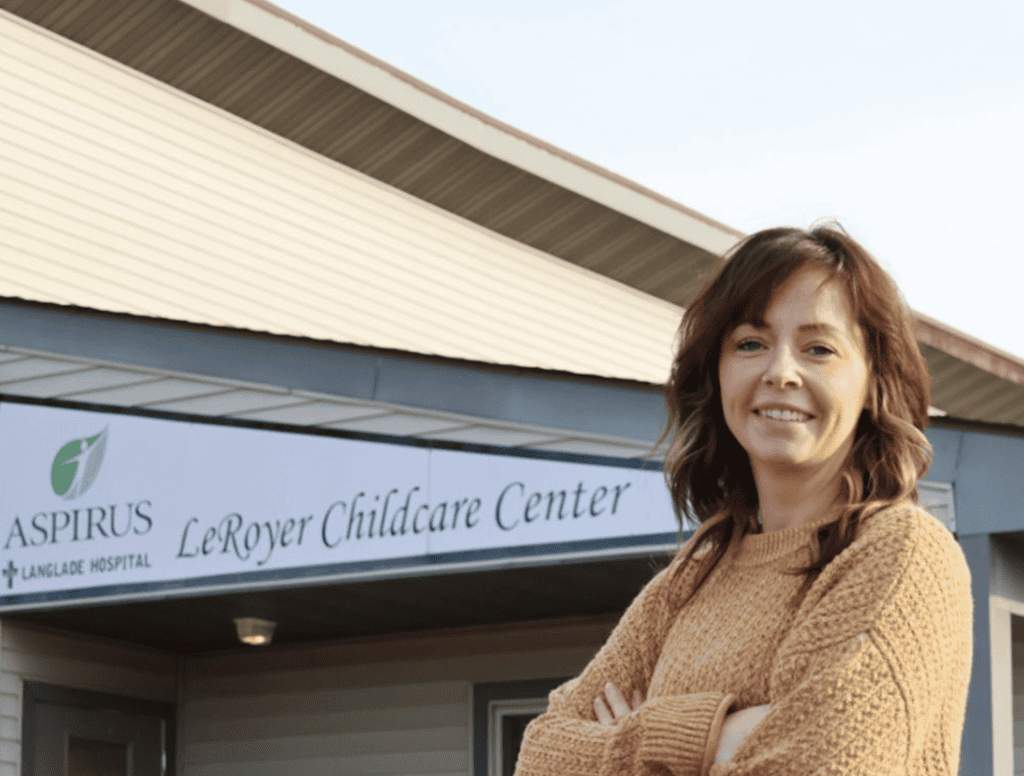
Langlade County Dream Up! Childcare Grant Highlights Need for Industry Support
To help support and fill gaps in North Central Wisconsin’s childcare industry, the Langlade County Economic Development Corporation created the Dream Up! Childcare Taskforce and grant program – most recently awarding the Aspirus LeRoyer Child Care Center in Antigo with a Dream Up! Grant.
Sam Zupon, supervisor for the Aspirus LeRoyer Child Care Center, said grant programs and initiatives like Dream Up! are essential to ensuring every parent has access to quality and affordable child care.
Zupon said not only is she a recipient of the grant, but she is also part of the county’s Dream Up! Childcare Taskforce.
“(We) are helping address the lack of child care in Langlade County and some surrounding counties, (and) I am part of that team,” she said.
The Dream Up! grant, Zupon said, was open to any licensed childcare facility to fund necessary safety and equipment upgrades.
“We used it toward some of the upgrades around the facility,” she said. “So, we got some child-sized potties instead of the adult potties, just to assist with potty training. We also got some safety pieces, like some non-slip step stools for the kids (because) in the bathrooms, it gets wet, and a plastic step stool tends to slip.”
Other upgrades currently underway at the center, Zupon said, include installing new furnace covers and constructing a private conference area for conversations between care providers and parents/guardians.
Zupon said the grant money further paid for new, easy-to-clean high chairs and “covered fingerprint checks for four of our employees.”
“Every five years they need new fingerprinting done, and (the grant) covered that as well,” she said. “We’re doing a little remodel here (because) our building is older, so the grant really helped (us pay for) some of the projects that normally we wouldn’t have been able to do within our budget.”
Childcare gaps
With much of the childcare discussion being centered around lack of availability and worker wages, Zupon said it’s important to support the facility, equipment and supply needs of childcare centers as well.
“There’s constantly something that needs to be replaced,” she said. “I mean, now we’re replacing our rugs. That’s not part of the grant, but they’re at the end of their life. They’re cleaned every week, (but) everything wears so quickly.”
Zupon said in the Langlade County area, the need for child care is prevalent but “age-specific.”
“I know between the three daycare centers (in the area), we have more openings for the three to five year olds – so the older kids,” she said. “(But) there really is a need for that birth to two years old (range), because (we’re) so limited with how many children you can have per teacher and how many you can have in the facility.”
According to the Wisconsin Department for Children and Families, a childcare center must employ one teacher per four children ages birth to two years old, and the maximum number of children in a group for that age range is eight.
“The little kids are so much more high-need,” Zupon said. “That’s where we really see the highest (need). I have three babies on my waitlist, and that’s (in addition to) four infants that will be starting throughout the end of summer.”
Zupon said she wishes the Aspirus LeRoyer Child Care Center could take on more infant-aged children, but because of the equipment needs and licensing requirements for that age group, her space doesn’t allow for it.
“Building-wise, it just doesn’t work,” she said. “Even the cribs, they take up so much space… (and) you can only have so many kids in a room to follow licensing (guidelines). I know there was talk about changing some of those ratios, because from infant to two years old, they’re all counted as the same care level. And really, (caring for) an infant is way different than caring for a one-and-a-half-year-old. So if the state would change some of the ratios, daycares could open up more spaces.”
Outside of the infant room, Zupon said further need exists for children who’ve even aged out of daycare.
“Usually, children age out of daycare when they go to school, so five to six years old,” she said. “(But, the) Boys and Girls Club isn’t available until (kids are) in first grade, which is (at age) seven. So there’s that gap for child care in the summer for kindergarten (and) first graders. We can accommodate some of those kids in the summer, but I know there is a need that way.”
‘Raising the future’
Beyond the typical services provided by childcare centers, Zupon said there is also a lack of resources for parents of children with special needs.
She said speech and occupational therapists employed by other entities and organizations are allotted hours to travel and serve the kids requiring those therapies in her facility, but that their time is limited.
“They struggle to have enough hours that they’re allotted to come and help children and they’re traveling to all the daycares and all the schools (in the area),” she said. “So they’re stretched thin too, and they just don’t have enough people either.”
Resources for parents of children with autism, Zupon said, are also unavailable in her area.
“We don’t have any in Langlade County, they want you to travel to Wausau for autism resources,” she said. “My son’s autistic, so I personally know the struggle with that. So if we could have resources like that in town, that would be fantastic, but it’s just hard.”
Zupon said she and her staff are “lucky” to be partnered with a larger healthcare system, as it helps alleviate some of the resource struggles other childcare centers experience.
“We’re lucky that we’re partnered with Aspirus – they support us in a big way,” she said. “But I feel like the (county’s childcare) task force has really brought to light the need that all of the daycares have for more support, because it’s not a money-making industry, that’s for sure. So (we appreciate) any grants and any support that the community can offer. I mean, we’re raising the future of this community, so any help is great.”
Childcare workers, Zupon said, are more than just trustworthy adults – they are trained professionals who must undergo strict and continued education, among other requirements, to continue working with and caring for children.
“They’re required to have CPR (training) and a fingerprint background check, and then there’s a couple of different classes you can take as part of the (education) requirements,” she said. “It really depends on the route you want to go, but that can be anywhere from one or two classes up to (an) associate’s degree… It can’t just be anybody with a high school diploma.”
Zupon said childcare workers also must complete 15 hours of continued education courses a year, “along with keeping up on your CPR (training) and background checks” – all of which costs money.
“I don’t think people understand that there are annual requirements, just like a nurse,” she said. “You have to keep up on this or you cannot be employed because of state licensing (requirements).”
State regulations, Zupon said, make operating a childcare facility costly and time-consuming, making it all the more necessary that the community supports the imperative industry.
“Any type of help is great, and when the community donates money or supplies or anything that’s a huge help,” she said. “Communities can help in that way too – you could donate a pallet of paper towels or something like that. It doesn’t always have to be just money. All those things are huge.”
Zupon said community support is especially appreciated since the childcare industry is typically responsible for children at their most developmentally vulnerable stage.
“You think about the little kids, the biggest development (of) their brain (happens) between zero and five years old, and that’s who we’re taking care of,” she said.
Written by: Rachel Kroeger for the The Business News
